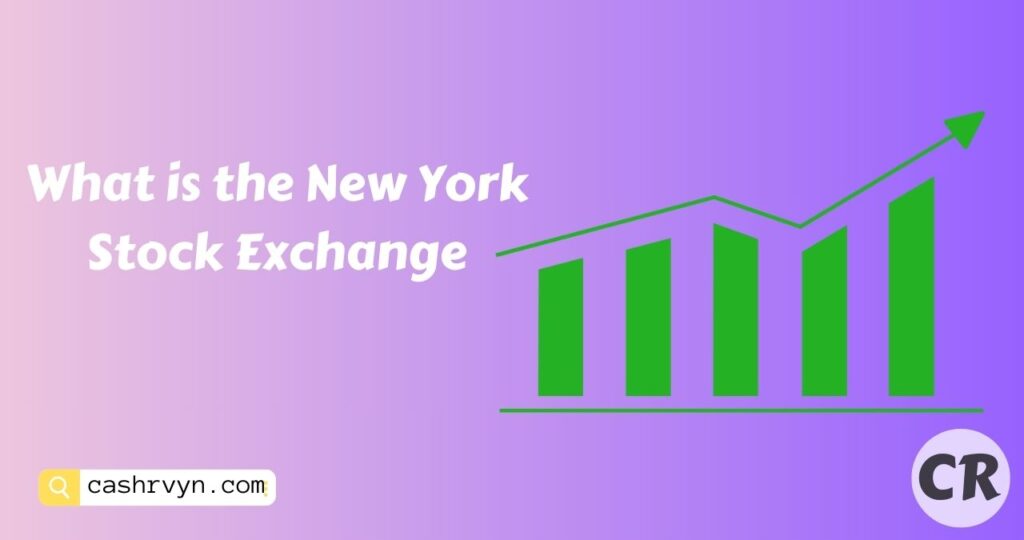The location where stocks are exchanged is called a stock exchange. In spite of this, the corporation issues shares of stock to its shareholders and raises money to expand its business.

This is also true of the New York Stock Exchange, which has even started to take on symbolic significance due to its capacity to help buyers and sellers complete deals. Over the years, the Wall Street-based New York Stock Exchange has established itself as a major player in the financial sector, and this status is expected to remain.
What is the New York Stock Exchange (NYSE)?
Based on the total market capitalization of the firms it lists, the New York Stock Exchange (NYSE) is the biggest stock exchange in the world. It is located in lower Manhattan’s Financial District and is where equity shares of publicly traded corporations are traded. Jamie Cox, managing partner at Harris Financial Group, explains that it enables businesses to efficiently obtain money in public markets where there is robust price discovery.
The New York Stock Trade (NYSE) will recognize its 231st birthday in May and “keeps on positioning as the world’s biggest stock trade, with public organizations worth a sum of $33 trillion,” as per Michael Harris, NYSE’s worldwide head of capital business sectors.
How the NYSE works
Brokers bid on shares of equities for their customers on the actual trading floor of the NYSE. However, in the wake of the epidemic and advancing automation technologies, the majority of trade is now conducted online. The NYSE provided both physical and electronic trading before the pandemic but was temporarily shut down due to government lockdown regulations.
Cox claims that the trade was being done by actual people. While it still takes place on the commodities exchange, the New York Stock Exchange is now mostly computerized, so the floor brokers are there to help with the market.
The floor brokers effectively create a market for a certain company’s securities so that shares of the stock may be purchased or sold, “and that way there’s ample liquidity to move the shares from one person to another,” according to Cox. Cox describes these individuals as “basically just facilitating dealings with human interaction, but they’re aiding the system’s matching of buyers and sellers.
Those wishing to sell certain stocks are listed on an electronic computer system alongside those who have placed purchase orders. Cox refers to it as “a modern-day livestock market” because floor brokers connect buyers and sellers on the computerized exchange based on the price they have agreed upon.
NYSE listing requirements
A public corporation must fulfill a variety of conditions before it may be listed and traded on the NYSE, including:
- 400 investors
- 1.1 million shares in the public market
- a $4.00 minimum share price
- For corporations intending to become public, the market value of such shares is $40 million, or $100 million for those wishing to list or transfer current securities.
- For the previous three fiscal years, pre-tax income must have been at least $10 million (although there are several exceptions to this criterion).
These specifications guarantee that the securities traded on the exchange are of a good quality. They are referred to by Harris as the “industry’s gold standard.” Companies must file an application to be listed on the NYSE in addition to meeting the listing standards.
The procedure consists of four steps: picking a market, reserving a ticker symbol, submitting an application, and appointing a designated market maker. If a corporation doesn’t adhere to the NYSE’s listing rules, it may potentially be delisted from the exchange.
For instance, the NYSE would start the delisting process if a company’s stock price fell below $1.00 for 30 consecutive trading days.
When is the NYSE open?
The NYSE bell, which chimes Monday through Friday, announces the beginning and end of the trading day. Orders may be submitted and queued during its pre-opening trading window, which starts at 6:30 a.m. ET. The primary trading hours are from 9:30 a.m. to 4:00 p.m. ET.
The following holidays are trading holidays for the NYSE:
- Christmas Day
- Day of Martin Luther King Jr.
- (Alternatively, Washington’s Birthday)
- Easter Friday
- Veterans Day
- Juneteenth, an American holiday
- Day of Labor
- Day of Thanksgiving
- Thanksgiving Day
How the NYSE has changed over time
The NYSE was founded in 1792 when a group of investors came to an agreement on how stocks could be exchanged. In 1817, these unofficial transactions became a formal corporation. The NYSE’s present structure, as we know it, was inaugurated in 1903. The NYSE didn’t get its first computers until the 1970s, which IBM claims significantly increased the pace of trading and more than quadrupled the number of shares traded. And a decade later, it had a market value of more than $1 trillion. The hybrid market was introduced by the NYSE in 2005 and combines floor-based auctions with computerized trading. Since that time, trading has always been conducted electronically, with more transactions being completed online than on a physical trading floor.
According to the head of markets at the NYSE, Jon Herrick, “our market model benefits from cutting-edge technology combined with the human judgments that floor traders contribute to our market model at critical moments.”
Nasdaq vs. NYSE
Compared to the NYSE, the Nasdaq is a considerably younger, entirely electronic exchange with a smaller market valuation. However, compared to firms registered on the NYSE, investors often perceive Nasdaq-listed companies to be younger, riskier assets. Being listed on the New York Stock Exchange has a certain cachet and lends credibility, according to Cox. Furthermore, the Nasdaq’s dealer market model permits dealers to determine prices alone, in contrast to the NYSE’s auction market model, which requires both buyers and sellers to bid.
The Takeaway
The NYSE and other exchanges are essential in terms of the information they retain, which is something that is often overlooked in the context of trading and investment, according to Cox. According to Cox, financial institutions may estimate the momentum of stocks by using the volume of information that crosses an exchange during buying and selling. Because of this, according to Cox, the NYSE is “probably more valuable for that specific segment of their company than any other at this moment,” since corporations and asset managers have grown sufficiently large to be able to trade amongst themselves. Therefore, in his opinion, the role of trade has diminished over time, although the knowledge shared on the market is almost priceless.







